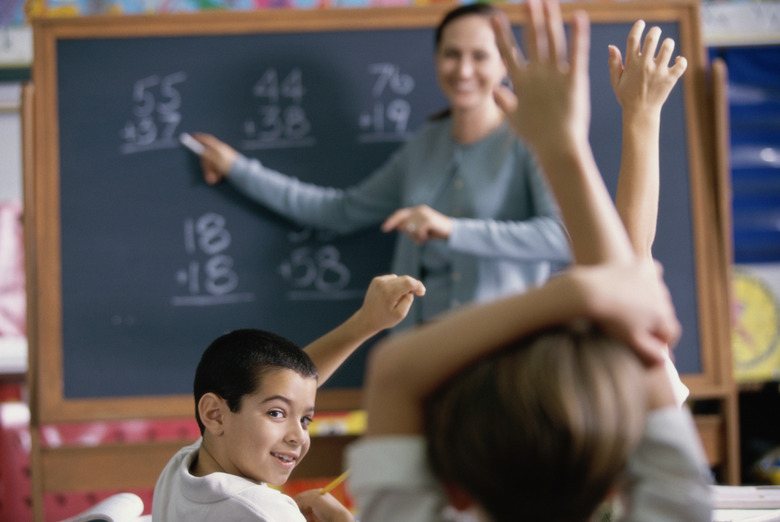How To Use Manipulatives To Teach Ratios
Many children learn by seeing and touching, and physical objects used as math manipulatives offer these students a concrete way to understand math concepts. In fact, using manipulatives helps children move from a concrete to an abstract level of understanding, according to the Yale-New Haven Teachers Institute. Help your students, regardless of their age, grade or skill level, understand the concept of ratios better by encouraging them to use manipulatives.
Basic Ratio Activities
Basic Ratio Activities
Younger children and students new to ratio concepts will need to start small with simple ratio exercises. Give each student a handful of small objects, making sure they each have 20 of one item and 10 of another. For example, provide each child with 20 pennies and 10 nickels. Have the children place two pennies next to one nickel and write the ratio 2:1 on the board. Discuss with the students that the ratio is 2:1 because there are two pennies for one nickel. Then ask the students to place 4 pennies next to two nickels and discuss how the ratio is still 2:1 because there are still two pennies for each nickel. Repeat the same activity with different ratios such 2:3 or 4:7. Also do the activity with different attributes such as the ratio of blue buttons to red buttons or the ratio of heart-shaped beads to star-shaped beads.
Surveys and Voting
Surveys and Voting
Older children can do more complex ratio activities. Hold a vote to determine the ratio of children who like fruit-flavored chewing gum versus how many like mint-flavored chewing gum. Have the students conduct a survey of their classmates or other students in the building to determine how many children like fruit gum and how many children like mint gum. Ask the children to use math manipulatives, such as actual pieces of gum, to show the ratio. For example, if for every five people who liked fruit gum, two people liked mint gum, their ratio would be 5:2 and would be shown with five sticks of fruit gum next to two sticks of mint gum. Do the same activity for other things such as favorite school lunch or what kind of pets students have at home.
Cooking Ratio Activities
Cooking Ratio Activities
Show students how ratios apply to real life with cooking activities. For example, doubling or tripling a recipe when cooking requires a basic knowledge of ratios. If a recipe for pancakes calls for 3 cups of flour and 1 cup of milk, the ratio of flour to milk is 3:1. To determine how much flour and milk a student needs to make a double batch of pancakes, students can use measuring cups in different colors as their manipulative. To show the double batch of pancakes, students might place six black measuring cups next to two white measuring cups, which still illustrates the ratio 3:1.
Ratio Game
Ratio Game
Divide students into two teams and give each team a bag of jellybeans that includes several different colors. Ask the teams to form a circle and have them dump their jellybeans into the middle. On your mark, call out two colors of jellybeans such as pink and green. The students must then separate all of their pink and green jellybeans, count them and agree on a ratio. For example, if a team has 10 pink jellybeans and 9 green jellybeans, the ratio would be 10:9. The team that correctly identifies their ratio earns a point. Continue playing with different color combinations.
Cite This Article
MLA
Ipatenco, Sara. "How To Use Manipulatives To Teach Ratios" sciencing.com, https://www.sciencing.com/how-to-use-manipulatives-to-teach-ratios-12747028/. 3 February 2011.
APA
Ipatenco, Sara. (2011, February 3). How To Use Manipulatives To Teach Ratios. sciencing.com. Retrieved from https://www.sciencing.com/how-to-use-manipulatives-to-teach-ratios-12747028/
Chicago
Ipatenco, Sara. How To Use Manipulatives To Teach Ratios last modified August 30, 2022. https://www.sciencing.com/how-to-use-manipulatives-to-teach-ratios-12747028/
